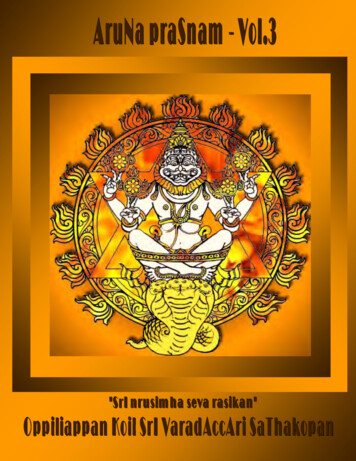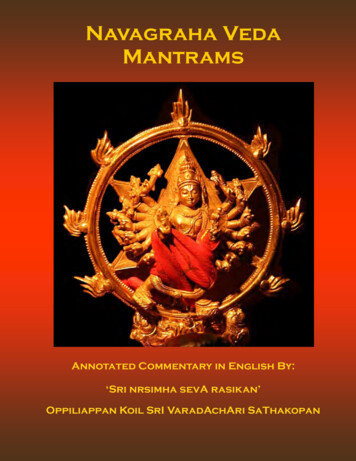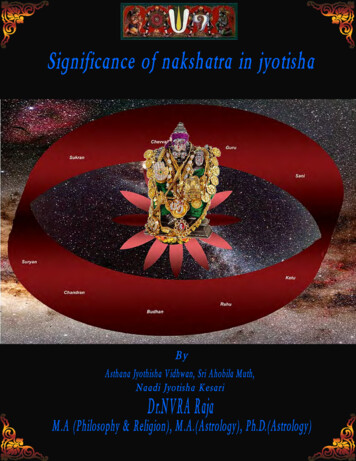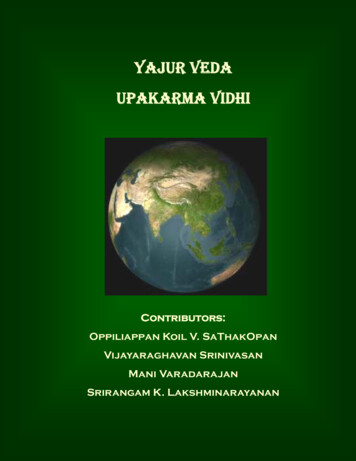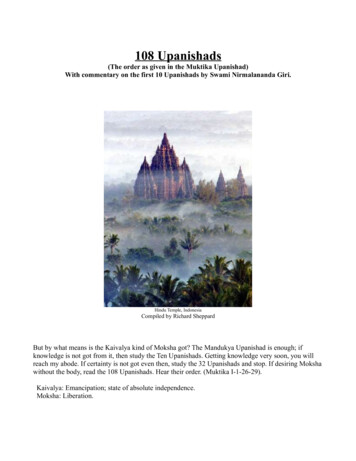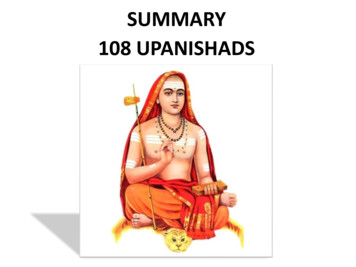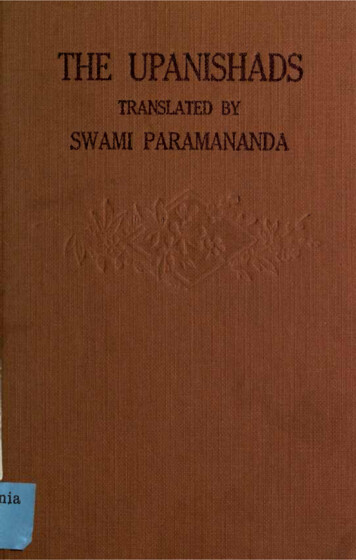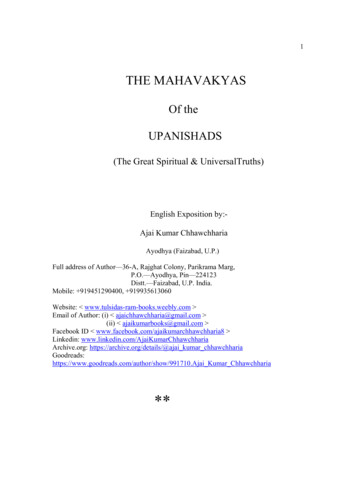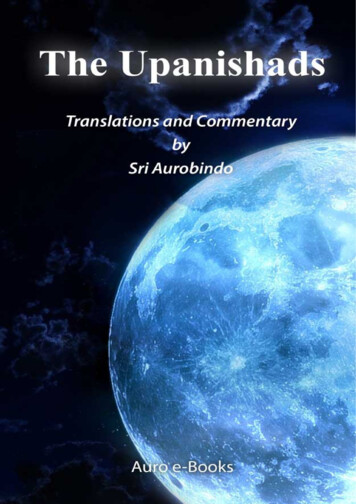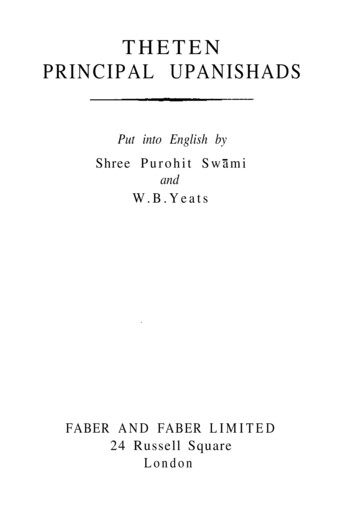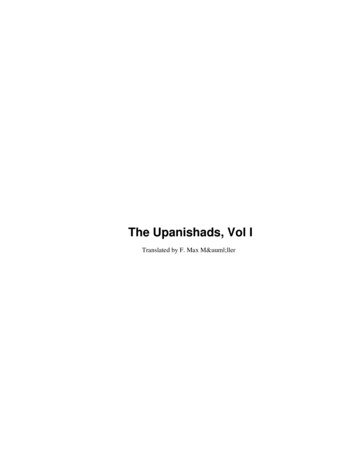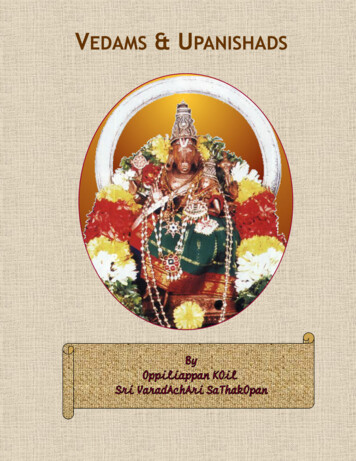
Transcription
VEDAMS & UPANISHADS
sadagopan.org
CONTENTS1The Two kinds of knowledge : Para and Apara Vidhyas12The Four categories of knowledge in VedAs23The Four kinds of VEda SamhitAs3-54108 Upanishads and Classification6-10sadagopan.org
sadagopan.org
॥ौीः॥VEDAMS & UPANISHADSThe two kinds of Knowledge: Para and Apara vidhyAsThe great tradition of the transmission of knowledge thru AchArya Mukham isrecorded in Mundaka Upanishad as a conversation between BrahmA, thecreator and his eldest son, AtharvA about the knowledge of BRAHMAN, thecorner stone of ALL knowledge. AtharvA taught what he had learned from hisfather to AngirA, who in turn taught it to SatyavAhA belonging to the clan ofBharadvAjA. SatyavAhA passed that supreme knowledge in succession to SageAngiras .humbly: “O Illustrious sage! kasminnu BhagavO vig nyAthE sarvamidhamvig nAtham bhavathee ? (What is that by the knowing of which all thisbecomes known?)Sage Angiras replied: "two kinds of knowledge needs to be known according tothe knowers of Brahman. They are the higher knowledge (parA) and the lowerknowledge (aparA)"Sage Angiras explained further that the lower knowledge is the Rig Veda, theYajur VedA, the Saama VedA and Atharva VedA, SikshA (phonetics), kalpA(rituals), vyAkarNam (grammer), NirukthA (etymology), chandas (metre) andJyOthisham (astronomy); and the higher knowledge is that by which theimperishable Brahman is attained.Sage Angiras said:"dhvE vidhyE vEdhithavyE ithi ha sma yadh BrahmavidhOvadanthi ParA chaivAparA cha". AparA are the four VedAs and their six angAsto understand the nature of DharmA and the ParA is the knowledge about theimperishable (akshaya) Brahman, which is the embodiment of DharmA. Thatomniscient, Omnipotent, all merciful Brahman has been defined as the source/origin, sustenance and dissolution of this multifaceted world according to the1sadagopan.orgSaunakA, the celebrated grahasthA approached Sage Angiras and asked
second Brahma sUthrA (JanmAdhyasya yatha:). That Brahman is cognized onlythrough the scriptures, the sources of authoritative knowledge about Brahman(Saasthra yOnithvAth: Brahma-sUthram 1.3). The next Brahma sUtram goes onto point out that Brahman is the main purport of all Vedic and upanishadictexts (tatthu samanvayAth). Thus one cannot dismiss the VedAs quickly asapara vidhyA and jump on to Para vidhyA. Rigorous study of the VedAs revealsto us the approach to Brahman, the para VidhyA, the ultimate goal for us all.The four categories of Knowledge in the VedAsThe four VedAs contain four important categories of knowledge related toDharmA:sadagopan.org1. Injunctions and Prohibitions2. Valedictory (praise) and deprecatory passages3. MantrAs and4. NamesAll these four are necessary to understand true DharmA or righteous dutyfrom different angles. Thus an inquiry in to them through the study of theVedAs becomes an essential pre-requisite in one's journey towards thecomprehension of Brahman (para VidhyA). The authority of the VedAs for us issupreme and final and hence a proper understanding of them with the help of aqualified AchAryA sets us on a safe footing to comprehend Brahman andachieve the parama purushArtham of Moksham. Our tradition is thereforecalled Vaidhikam or the one based on the authoritativeness of the VedAs.2
The four kinds of Veda SamhithAsAtharva SamhithARig, Yajur, Saama and Atharva samhithAs constitute the four VedA samhithAs.Each of them have more than one branch (SaakA). The oldest VedA isrecognized as Rig Vedam and the youngest is the Atharva Vedam. Latter hasnine branches or rescensions (navadhAatharvaNO veda:).These nine branches are:(4) SaunakIya(7) BrAhmaveda(2) Tauda(5) Jaajala(8) Devadarsa and(3) MuNda(6) Jalada(9) ChAraNavaidya.Today, only two of the nine branches of Atharva Vedam (Saunakha andPaippalAda) are available to us. The Delhi Vedic trust has recorded theSaunakha sAkA .The Atharva Veda samhithA has 5977 verses spread over 20 KhAndams(books/chapters). The khAndams are further subdivided into hymns and theyin turn house a group of manthrAs. Some prefer to catalogue the Atharva VedaText (SamhithA) into prapaathakAs (Lessons or lectures). Under thisclassification, there are 34 prapAthakAs that house the 5977 verses. vanthAdhiisconsidered as the essence of Atharva Vedam.The Delhi Vedic trust has recorded the 20 KhAndhams of Atharva Vedam in 14audiotapes.Rg Veda SamhithAThis ancient Vedam has 1,028 sUkthams (hymns) and contains in all 10,589verses. These are grouped into either 8 KhAndAs or 10 MandalAs with 85anuvAkAs (subsections). There used to be 21 sakAs (redactions) of the RigVedAs. There is only one available today. That is Saakala SaakA. IythrEya3sadagopan.org(1) PaippalAda
Upanishad belongs to Rig Veda SamhithA. NammAzhwAr's Thiruviruttham isconsidered as the Veda SaarArtham of Rig Vedam.The Delhi Vedic Trust has recorded Saakala sAkA in 27 ninety minute tapes.Yajur Veda SamhithAThis Vedam has 1975 verses grouped under 40 chapters known as adhyAyAs.The longest chapter has 117 "verses" and the shortest chapter has 13"verses".There are two Yajur samhithAs: Sukla and KrishNa (White andBlack) samhithAs. The White Yajur Veda samhithA is also known as VajasanEyi- MadhyAndina Sukla Yajur vedam to distinguish it from KrishNa Yajur Veda orTaittiriya SamhithA, which is generally considered to be more close to asadagopan.orgBrahmaNA rather than to a Sruthi. Most of the people in AndhrA and TamilNaadu are KrishNa Yajur Vedins.The two samhithAs have number of recession in view of their wide popularity.These variations arose from a variety of textual differences and theirapplications in Vedic rituals. The two popular recensions of the Sukla YajurVedam are: MaadhyAndhina and KaaNva; the KrishNa Yajur Vedam has threerecensions: kAtaka, Kapishtala-Kata and MaithrAyaNee.Saama samhithAIn its importance in YaagAs and sacredness, Saama Veda SamhithAs rank nextto Rig VedA. The Lord of GeethA however has put this Saama samhithA on thetop of all four SamhithAs with His declaration that He is Saama VedA amongthe VedAs. This samhithA consists of hyms chanted by udhgAtri priests at theSoma YaagAs. Many of the hymns originate from Rig Vedam and have beenrearranged without reference to the original order in the Rig Vedam and set tomusic. Only 75 verses of the total of 1,875 verses of Saama Vedam are not tobe found in Rig Vedam. The remaining 1,800 verses are essentially therepetitions of Rig Vedic verses. The important distinction however is that theyare sung instead of being recited. The Rig Vedam deals with knowledge andSaama Vedam deals with UpAsanA, Worship and DhyAnam.According to one classification, the Saama samhithA is catalogued under two4
sections:PurvArchikA and UttarArchikAEach archikA is subdivided into prapaathakAs and adhyAyAs. In anotherclassification, the 1875 verses are grouped under FOUR categories:1. PurvArchikA: 585 verses (1-585 )2. AraNya KhAndam : 55 verses ( 586-640 )3. MahAnAmnyArchikA : 10 verses( 641-650 )4. UttarArchikA: 1225 verses ( 651-1875)In singing, the priests of the Yaj nams follow specific styles throughalteration of prolongation, repetition, modulation, rests et al. These becomethe various styles of Saama GhAnams: congregational (GrAma gEya GhAnam),Saama Vedam had originally 1001 branches. We have very few left now.NammAzhwAr's celebrated Thiruvaimozhi is recognized as the Saama VedaSaarArtham.5sadagopan.orgAraNya ghAnam (Forest song style), Uha ghAnam and Uhya GhAnam.
108 Upanishads and their classificationUpanishads and Veda SaakaasUpanishads are found in the concluding sections of the Veda Saakaas andhence are known as Vedanta or the end of the Vedas. There are four VedaSamhitas (Rg, Yajur, Sama and Atharva). The Yajur Vedam has two Samhitasknown as the Krishna and Sukla Yajur Vedas. Hence, One can say that thereare 5 Veda Samhitas, if we take into account the 2 Samhitas of Yajur Veda.Each of the 4 Samhitas referred to above has several branches or Saakaas.Each Saaka has a Karma Khanda dealing with the actions to be performed andis made up of Mantras and Brahmanaas. Latter deals with Upasana orsadagopan.orgmeditation and has Aranyakas inside them for the benefit of those who haveresorted to the quiet habitat of the forest to pursue their spiritual Quest.The Upanishads are found mostly in the Aranyaka section of the Vedas.The traditional view is that Vysa Bhagavan has classified the four Vedas into1180 Saakaas and each of these Saakaa is associated with an Upanishad.Hence, One anticipates 1180 Upanishads. According to this view, there musthave been 21 Upanishads for the 21 Rg Saakaas, 109 for Yajurveda, 1000 forSama Veda and 50 for the Atharva Veda. Most of these Saakaas have beenlost with the passage of time and we are left with 108 Upanishads today.The breakdown among the 108 Upanishads according to the 5 Veda Samhitasare as follows:1. Rg Veda: 102. Sama Veda :163. Atharva Veda: 314. Krishna Yajur Veda: 325. Sukla Yajur Veda: 196
The 10 Upanishads belonging to the Rg Veda are the following:1. Aitareya*6. Mudgala2. Kaushitaki7. Akshamala3. Nadabindu8. Tripura4. Atmabodha9. Subhagyalakshmi and5. Nirvana10. Bahvrichi.The 16 associated with the Sama Samhita mani12. Kundika3.Arunika8.Vasudeva13.Savitri4. nyasa15.Jabaladarsana16.JabaliThe 19 Upanishads belonging to Sukla Yajur Veda are:1. Isavasya*7.Mantrika13.Bhikshuka2. Brahadaranyaka*8.Niralamba14. Turiyatita3. Jabala9.Trisikhibrahmana15.Adhyatma4. Hamsa10.Mandalabrahmana16.Yajnavalkya5. ParamaHamsa11.Advayataraka17.Satyayani6. rg1.Kena*
sadagopan.orgThe 32 Upanishads belonging to the Krishna Yajur Veda Samhita lini4.Kaivalya12. Sarvasara20.Sariraka28. kha29.Pranaagnihotra6.Garbha14. Tejobindhu22. Ekakshara30.Varaha7.Narayana15. Dhyanabindhu23. Akshi31. Kalisantaranaand8.Amritabindhu16.Brahmavidya24. Avadhuta32.SarasvatirahasyaSome of the 31 Upanishads belonging to the Atharva samhita are :1. Prasna*9.Sita17.Surya25. Maandukya*11.Tribadvibhuti19. Pasupatabrahma 27. ma28.Krishna5.Atharvasikha13. Ramatapini21. Tripuratapini29. Hayagriva6. Brahajjabala14.Sandilya22. Devi30.Dattatreya7. Nrsimhatapini15.Paramahamsa23. Bhavana31. Garuda8. Narada16. Annapurnamahanarayanaparivrajaka24. BhasmajabalaIn the above list of 108, those marked with the Asterik (*) sign are the tenMajor Upanishads commented on by AchAryAs.Besides the major Upanishads, there are 27 Upanishads known as SamaanyaUpanishads, because they deal with teachings of general (Samaanya) interestto all. There are 14 Saiva Upanishads dealing with Siva; 8 Sakta Upanishadsdealing with Sakti or Devi; 14 dealing primarily with Vishnu and hence known as8
Vaishnavopanishads; 20 Yoga Upanishads dealing with different aspects ofYoga and 17 Sanyasa Upanishads dealing with the rules and different aspectsof Sanyasa or Renunciation.Some of the 27 Samaanya Upanishads are:10. Vajrasuchi(S)19. Surya(A)2. Garbha(KY)11. Atmabodha(R)20.Akshi (KY)3. Maitrayani(S)12. Skanda(KY)21. Adhyatma(SY)4. Kaushitaki(R)13. Mudgala(R)22. Savitri(S)5. Subala(SY)14. Paingala(SY)23. Atma(A)6. Mantrika(SY)15. Mahat(S)24. Pranaagnihotra(KY)7. Sarvasara(KY)16. Sariraka(KY)25. Muktika (SY)8. Niralamba(SY)17. Ekakshara(KY)9. Sukarahasya(KY)18. Annapurna(A)Thus 15 out of the 27 belong to the two Samhitas of Yajur Vedam.The 14 Saiva Upanishads are:1. Kaivalya(KY)6. Dakshinamurthi(KY)11. Rudrakshajabala(S)2. Atharvasira(A)7. Sarabha(A)12. Ganapati(A)3. Atharvasikha(A)8. Akshamaala(R)13. Panchabrahma(KY)4. Brahajjabala(A)9. Rudrahrudaya(S)14. Jabali(S)5. Kaalagnirudra(KY)10. Bhasmajabala(A)The 8 Sakta Upanishads are:1. Sita(A)2. TripuratapiniAnnapurna(A) 3. Devi(A)5. Bhavana(A)6. Saubhagyalakshmi (R)4. Tripura(R)7. Sarasvatirahasya(KY) 8. Bahvrichi (R)9sadagopan.org1. Svetasvatara(KY)
The Dominance of Rg Vedic connection indicates the ancient nature of SaktiWorship. The 14 Vishnava Upanishads are:1. Narayana (KY)6. Vasudeva(S)11. Hayagriva(A)2. Nrsimhatapini (A)7. Avyakta(S)12. Dattatreya (A)3. Tripadvibhutimahanarayana (A)8. Tarasara(SY)13. Garuda (A)4. Ramarahasya(A)9. Gopalatapini (A)14. Kalisantarana (KY)5. Ramatapini (A)10. Krishna(A)It is interesting to see 9 out of 14 belong to the Atharva Samhita.Yoga Upanishads and Sanyasa Upanishads constitute 37 of the 108.sadagopan.orgThe seventeen Sanyasa Upanishads among the 37 are:1. Brahma(KY)7. Narada Parivrajaka(A),13.Parabrahma(A),2. Jabala(SY),8. Bhikshuka(SY),14. Avadhuta(KY),3. Arunika(S),9. Turiyatita(SY),15. Katharudra(KY)4. Paramahamsa(SY),10.Sanyasa(S)16. Yajnavalkya(SY)5. Maitreyi(S),11. Paramahamsaparivrajaka(A),17. Satyayani (SY)6. Nirvana(R)12. Kundika(S),The remaining 20 belong to the Yoga Upanishads. Fifteen of these 20Upanishads belong to the two Samhitas of the Yajur Vedam. Three belong toAtharva, two to Sama and one to Rg Veda Samhita. Yoga has been defined asKarmasu Kowsalam. One wonders about the dominance of Yajur Veda Samhitaamong the Yoga Upanishads.Daasan, Oppiliappan KOil VaradAchAri SaThakOpanƒ ƒ10
The Upanishads are found mostly in the Aranyaka section of the Vedas. The traditional view is that Vysa Bhagavan has classified the four Vedas into 1180 Saakaas and each of these Saakaa is associated with an Upanishad. Hence, One anticipates 1180 Upanishads. According to this view, there must have been 21 Upanishads for the 21 Rg Saakaas, 109 for Yajurveda, 1000 for Sama Veda and 50 for the .
